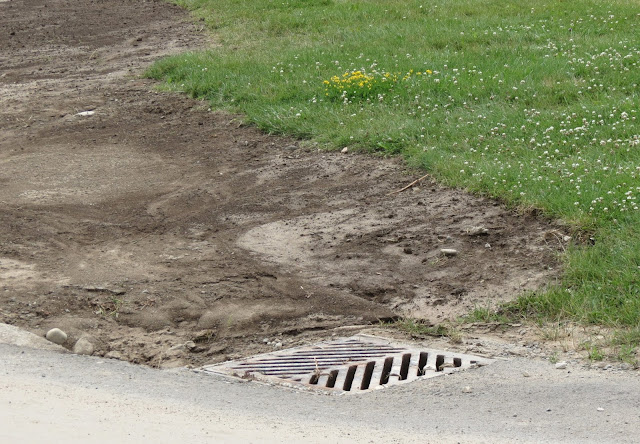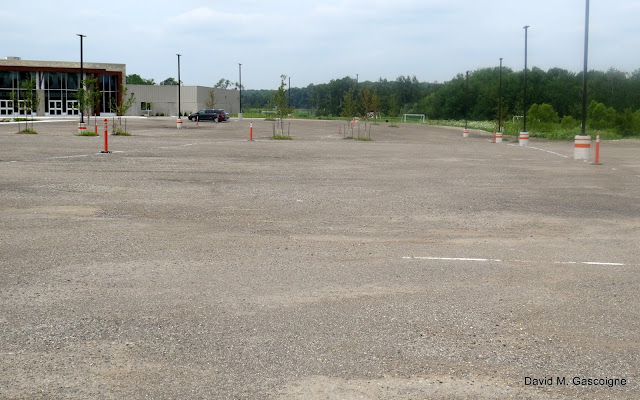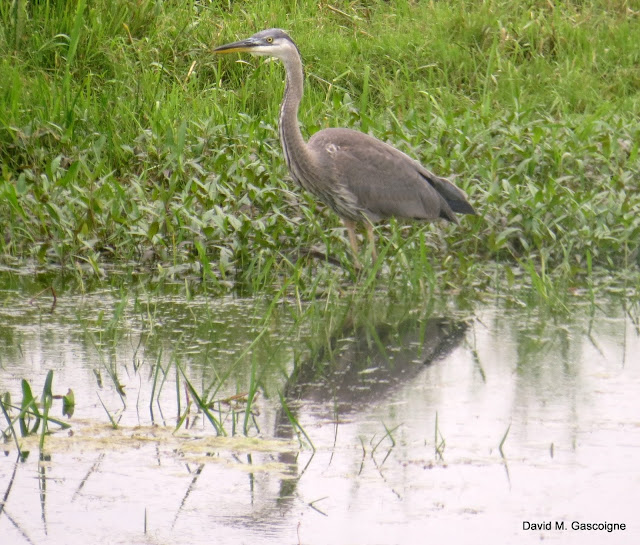On Wednesday evening a pot luck supper was held for the volunteers of the Peregrine Falcon Falco peregrinus fledge watch. Chris and Karen von Knobloch kindly hosted this event and it was attended by many of the regular falcon monitors.
Rudy Kruppa, the falconer involved with our team, brought a couple of his birds with him, and everyone was able to have close and intimate encounters with a Harris's Hawk Parabuteos unicinctus and a Red-tailed Hawk Buteo jamaicensis.
 |
| Harris's Hawk |
 |
Red-tailed Hawk
Harris's Hawk seems to be the most universally used species by falconers and those seeking to control other birds, such as at airports and of all places, far from its habitat in the southwestern desert of North America, in Trafalgar Square. When Miriam and I last visited there a falconer was walking around with a Harris's Hawk on his arm and there was nary a pigeon in sight.
Here is a closeup of the two species.
Given our druthers, we would prefer to see these birds in the wild, but given the fact that they are routinely and legally kept in captivity, Miriam did not let the opportunity pass her by to have an up close and personal encounter with a magnificent raptor.
|
Thanks again to Chris and Karen for hosting the event and for barbecuing the most delicious, succulent chicken I have ever tasted!
Many regular readers of my blog will have seen the numerous posts I have made about the wonderful little wetland at Creekside Church.
Here are a few idyllic scenes from that wetland.
 |
| Northern Rough-winged Swallow |
 |
| Tree Swallow, Barn Swallow, Eastern Kingbird |
 |
| Barn Swallow |
 |
| Midland Painted Turtle |
 |
Barn Swallow, Red-winged Blackbird
Imagine my utter shock the other day when I discovered that this wetland had been drained. To say I was dumbfounded would be an understatement. To say that I was offended, disgusted, disappointed, mad as hell, would hardly represent my true feelings.
It is not permitted to drain a wetland in this area without a permit from the Grand River Conservation Authority. Today it was confirmed that no such permit was issued. And this from a church, a supposed bastion of propriety in the community, acting illegally.
Furthermore the whole operation smacks of deceit. The pond was drained on a weekend when minimal public scrutiny is likely. The leaders of the church turned on the tap and walked away, without any concern for the creatures that live in the pond. How many Midland Painted Turtles baked in the hot summer sun, where did the Muskrats go, what happened to all the other organisms? How many fish were sucked into the storm drains? How many Red-winged Blackbirds' nests in the reeds were disturbed?
And when a few concerned citizens started poking around and asking questions, and taking pictures, the contractor came back on Monday morning to widen and deepen the trench to make sure the job was completed. Death to any critters that might have survived the initial onslaught.
This area was considered by the study team for the North Waterloo Scoped Subwatershed Study to be a Significant Wildlife Habitat candidate and a Turtle Breeding Area candidate. Thirty-seven turtles have been counted there on a single day.
There are photographs dating back to 1930 that show a pond of similar size and location suggesting it is a natural pond and not a storm water pond built by the church.
This is what the area now looks like.
Make no mistake, areas in the pictures above that look like water do not contain water. It is mud that has not yet dried out. ALL the water has gone.
It is not as though the church needs more space. Judge for yourself the extent of their parking lots following a recent expansion of their buildings.
|
I am truly filled with revulsion. I cannot adequately express either my sadness or disgust. I just hope that all those worshippers thanking their god for all his bounty, and thanking him for all of creation will remember what they have done to some of it. But somehow I doubt it.
It's ironic that the Pope, a leader of another significant branch of christianity, is calling for his flock to become environmentally conscious and respect the earth. This credo has obviously not filtered down to Creekside Church, unfortunately, and we are all the more bereaved. It is a sad, sad day in Waterloo.
As mentioned in my last post most birds are involved with procreation at this time of year, with photographic opportunities relatively scant unless one is near an expanse of water. So, I have focused my efforts of late on wildflowers and the results are shown below.
Birdsfoot Trefoil Lotus corniculatus is not native to this area, but is widespread and irrevocably part of the flora now. It is quite incredible, really, how greatly immigrants to North America longed for the familiar plants of home and brought them here. Some are relatively innocuous, but others have become truly invasive and native vegetation and the wildlife it supports have suffered greatly as a result.
Another introduced species which can be commonly found is Cow Vetch Vicia cracca.
Even though North America has its own buttercup species, I suppose that nothing was considered quite as beautiful as the Common or Tall Buttercup Ranunculus acris and it too was introduced and has multiplied profusely.
Chicory Cichorium intybus was also imported from Europe, perhaps as an ingredient for coffee, and it too has become well established.
The Red Osier Cornus stolonifera, a member of the dogwood family, is native to the area (hooray!) and by now is sporting a full crop of berries.
Queen Anne's Lace Daucus carota is very common and can be found in scrubby, weedy habitats throughout the region.
Common Tansy Tanacetum vulgare is often located alongside Queen Anne's Lace.
In the same locations one may also find Yarrow Achillea millefolium.
Where there are flowers there are butterflies and this Red-spotted Purple Limenitis arthemis atyanax was in very poor condition. It is doubtful that it could function with that kind of wing damage and I suspect that it would quickly become a tasty snack for an insectivorous bird.
The title of my blog is Travels with Birds and so no post would be complete without at least one picture of a bird; here is a Great Blue Heron Ardea herodias patrolling along the river's edge in Hawkesville.
A couple of days ago Miriam and I went for a walk at RIM Park. It was a glorious, sunny day, redolent with summer activity, but certainly muted in terms of bird life. These are indeed the dog days of summer when most species have stopped singing, and adults are busy doing everything they need to do to launch their young into the world, and staying as unobtrusive as possible. Many interesting facets of nature are present, however, and for even the casual observer there is much to enjoy.
This nest of Baltimore Oriole Icturus galbula was no doubt home to a family, and we saw adults busy delivering food to fledged young.
Common Milkweed Asclepias syriaca was blooming profusely, and the sheer range of insect life it harboured was a forceful reminder of how critical this plant is to many species.
Here it is with a Virginia Ctenuchid Moth Ctenuche virginea, a diurnal species, feeding on the flower.
Great Spangled Fritillaries Speyeria cybele were easy to find and milkweed was their choice of plant also.
The tiny Edward's Hairstreak Satyrium edwardsii always seemed to be cooperative and showed its colours when we wanted to take a photograph. It is joined by a whole group of Virginia Ctenuchid Moths.
Sensitive Fern Onoclea sensibilis was not hard to find.
The Tiger Lily, profuse in many habitats, even alongside roads, is in the genus Lilium, but is really hard to pin down as to species. It is a gloriously beautiful plant.
Red Clover Trifolium pratense was imported from Europe by early settlers as a forage crop and found an environment much to its liking and is now ubiquitous.
We are first and foremost birders, so it seemed entirely appropriate that right as we left the park we saw a group of juvenile Barn Swallows Hirunodo rustica waiting to be fed by their parents. It is quite incredible how the adults can swoop in at top speed and stuff an insect into the waiting bill of the juvenile without reducing speed. It is a true feat of coordination.
What a pleasant walk it was. We need to get out and do it again today!
Our garden is now in that wonderful lush state that mid-summer brings and we have been host recently to a range of birds feeding young.
Among the most endearing has been a pair of adult Downy Woodpeckers Picoides pubescens with just one juvenile male. Over time they have become more and more accustomed to us and now if we sit quietly at the patio table they carry on with their business quite unconcerned.
Both parents are active in feeding their youngster but from what we have observed the male seems to do the lion's share of the work.
However, the female is never far away and gets involved too.
The male is quite an acrobat (as are all woodpeckers, of course) and seems to prefer to hang from the bottom of the suet feeder and sometimes remains there motionless for minutes on end.
We have been left wondering what mishap might have befallen the other young of this pair's clutch, but the remaining offspring seems healthy and robust and is no doubt benefitting from exclusive access to parental care. He is perfectly capable of feeding himself but whenever an adult is near he reverts to wing fluttering and begging for food, to which the parent responds without fail.
We certainly have enjoyed being a witness to this woodpecker saga and will be a little sad perhaps when the youngster gains full independence and no longer comes as part of a family group.
Land Acknowledgement
We acknowledge that the land on which we are situated are the lands traditionally used by the Haudenosaunee, Anishinaabe, and Neutral People. We also acknowledge the enduring presence and deep traditional knowledge, laws, and philosophies of the Indigenous Peoples with whom we share this land today. We are all treaty people with a responsibility to honour all our relations.












































































.jpg)
